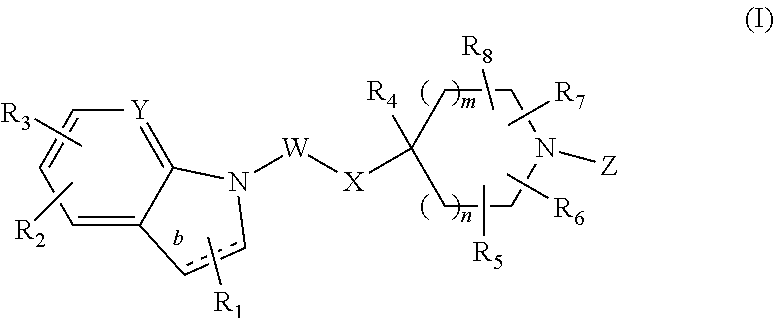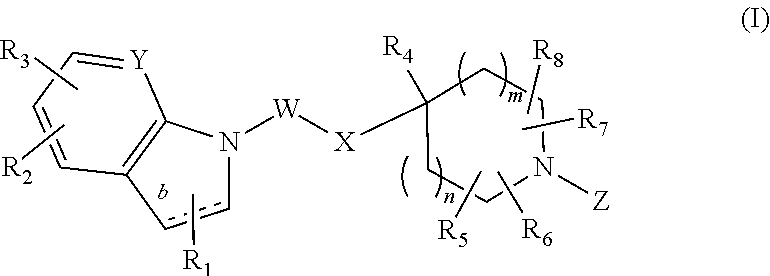Bicyclic GPR119 modulators
a gpr119 and bicyclic technology, applied in the field of heterocyclic compounds, can solve the problems of no cure for diabetes, no orally bioavailable, abnormally high glucose level in the blood,
- Summary
- Abstract
- Description
- Claims
- Application Information
AI Technical Summary
Benefits of technology
Problems solved by technology
Method used
Image
Examples
example-1
tert-Butyl-4-((6-(5-(methylsulfonyl)-1H-indol-1-yl)pyridin-3-yl)oxy) piperidine-1-carboxylate
[0227]
[0228]To a mixture of 4-((6-chloropyridin-3-yl)oxy)piperidine-1-carboxylate (intermediate-6) (0.440 g, 1.4 mmol) and 5-(methylsulfonyl)-1H-indole (intermediate-21) (0.261 g, 1.3 mmol) in anhydrous dioxane (5 mL), 2-(2′-Di-tert-butylphosphine) biphenylpalladium(II)acetate (0.130 g, 0.281 mmol) and NaOtBu (sodium tert.butoxide) (0.312 g, 0.960 mmol) were added. The resultant reaction mixture was refluxed for 4-5 h. The reaction mixture was filtered over celite and filtrate was concentrated in vacuo. The residue was purified by flash column chromatography to give tert-butyl 4-((6-(5-(methylsulfonyl)-1H-indol-1-yl)pyridin-3-yl)oxy)piperidine-1-carboxylate (0.337 g, 50%).
[0229]1H NMR (400 MHz, CDCl3) δ; 1.47 (s, 9H), 1.82 (bs, 2H), 1.98-2.08 (m, 2H), 3.08 (s, 3H), 3.37 (bs, 2H), 3.73 (bs, 2H), 4.55 (bs, 1H), 6.82 (bs, 1H), 7.42 (bs, 2H), 7.71 (bs, 1H), 7.79 (d, J=9.2 Hz, 1H), 8.18 (d, J=8.4...
example-2
1-(5-((1-(5-Ethylpyrimidin-2-yl)piperidin-4-yl)oxy)pyridin-2-yl)-5-(methyl sulfonyl)-1H-indole
[0230]
[0231]To a stirred solution of example-1 (0.1 g, 0.212 mmol) in dichloromethane (5 mL) trifluoroacetic acid (0.5 mL) was added at 0° C. and stirred at room temperature for 2-3 h. The solvent was removed in vacuo and the resulting salt was dissolved in 2-propanol (3 mL), diisopropylethylamine (0.082 g, 0.635 mmol) and 2-chloro-5-ethylpyrimidine (0.039 g, 0.275 mmol) were added and stirred at 160° C. for 3 h. The suspension was passed through celite, the filtrate was concentrated and the resulting residue was purified by flash column chromatography to give 1-(6-((1-(5-ethylpyrimidin-2-yl)piperidin-4-yl)oxy)pyridin-2-yl)-5-(methylsulfonyl)-1H-indole as white solid (0.054 g, 24%).
[0232]1H NMR (400 MHz, CDCl3) δ; 1.20 (t, J=7.2 Hz, 3H), 1.87-1.89 (m, 2H), 2.04-2.09 (m, 2H), 2.48 (q, J=7.6 Hz, 2H) 3.09 (s, 3H), 3.65-3.70 (m, 2H), 4.21-4.24 (m, 2H), 4.65 (bs, 1H), 6.83 (s, 1H), 7.41-7.48 (m,...
example-3
tert-Butyl-4-(4-(5-(methylsulfonyl)-1H-indol-1-yl)phenoxy)-piperidine-1-carboxylate
[0233]
[0234]The title compound was prepared by following the similar procedure as described in Example-1 by using 5-(methylsulfonyl)-1H-indole (intermediate-21) and tert-butyl-4-(4-bromophenoxy)piperidine-1-carboxylate (intermediate-77) (0.130 g, 24%).
[0235]1H NMR (400 MHz, CDCl3) δ; 1.49 (s, 9H), 1.85-1.86 (m, 2H), 1.96-2.01 (m, 2H), 3.09 (s, 3H), 3.36-3.43 (m, 2H), 3.71-3.77 (m, 2H), 4.54-4.56 (m, 1H), 6.80 (dd, J=3.2, 0.4 Hz, 1H), 7.07, (dd, J=6.8, 2.4 Hz, 2H), 7.38 (dd, J=6.8, 2.0 Hz, 2H), 7.42 (d, J=3.2 Hz, 1H), 7.54 (d, J=8.8 Hz, 1H), 7.74 (dd, J=1.6, 8.4 Hz, 1H), 8.33 (d, J=4 Hz, 1H); MS: 471 (M+1).
PUM
| Property | Measurement | Unit |
|---|---|---|
| temperature | aaaaa | aaaaa |
| temperature | aaaaa | aaaaa |
| temperature | aaaaa | aaaaa |
Abstract
Description
Claims
Application Information
 Login to View More
Login to View More - R&D
- Intellectual Property
- Life Sciences
- Materials
- Tech Scout
- Unparalleled Data Quality
- Higher Quality Content
- 60% Fewer Hallucinations
Browse by: Latest US Patents, China's latest patents, Technical Efficacy Thesaurus, Application Domain, Technology Topic, Popular Technical Reports.
© 2025 PatSnap. All rights reserved.Legal|Privacy policy|Modern Slavery Act Transparency Statement|Sitemap|About US| Contact US: help@patsnap.com



